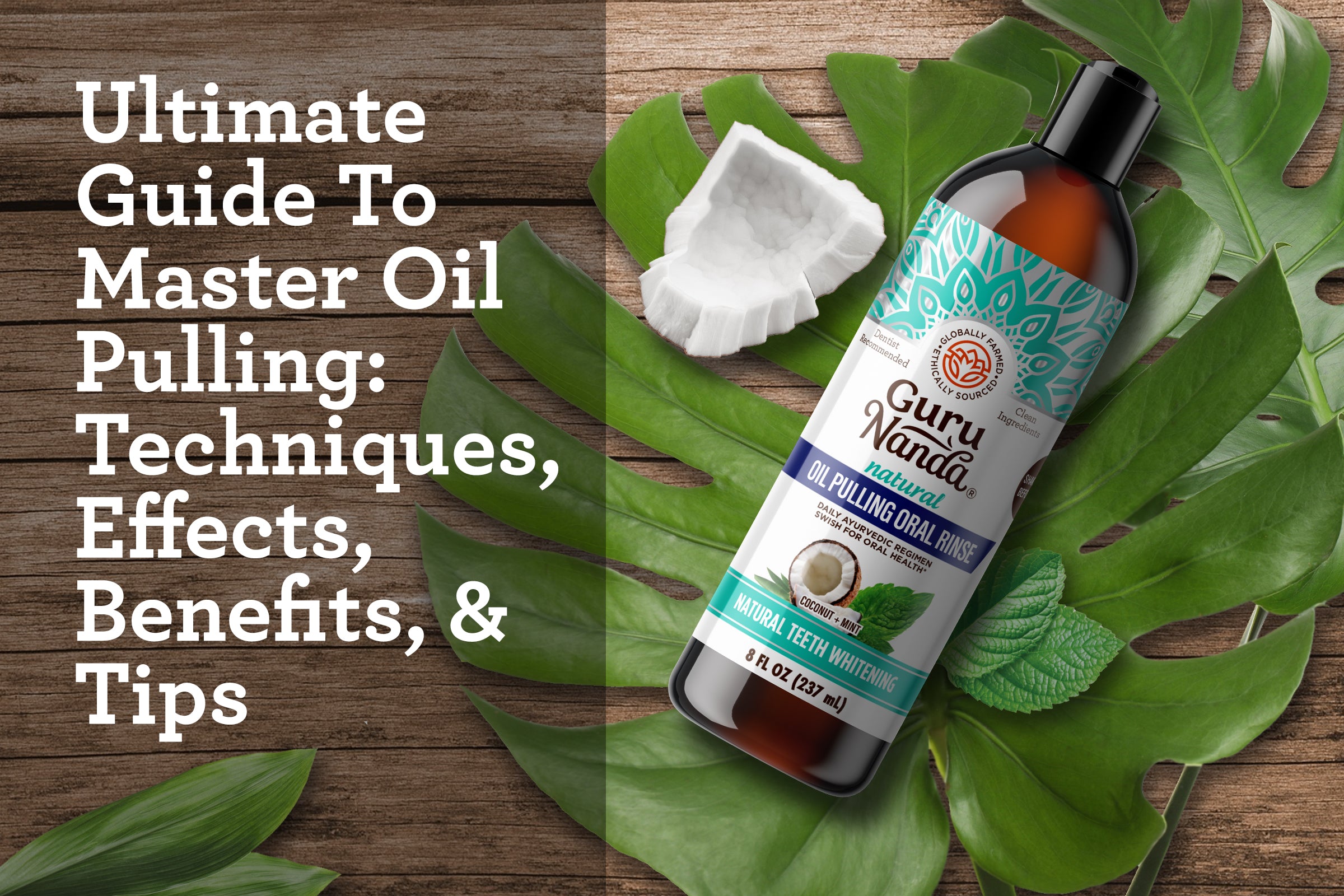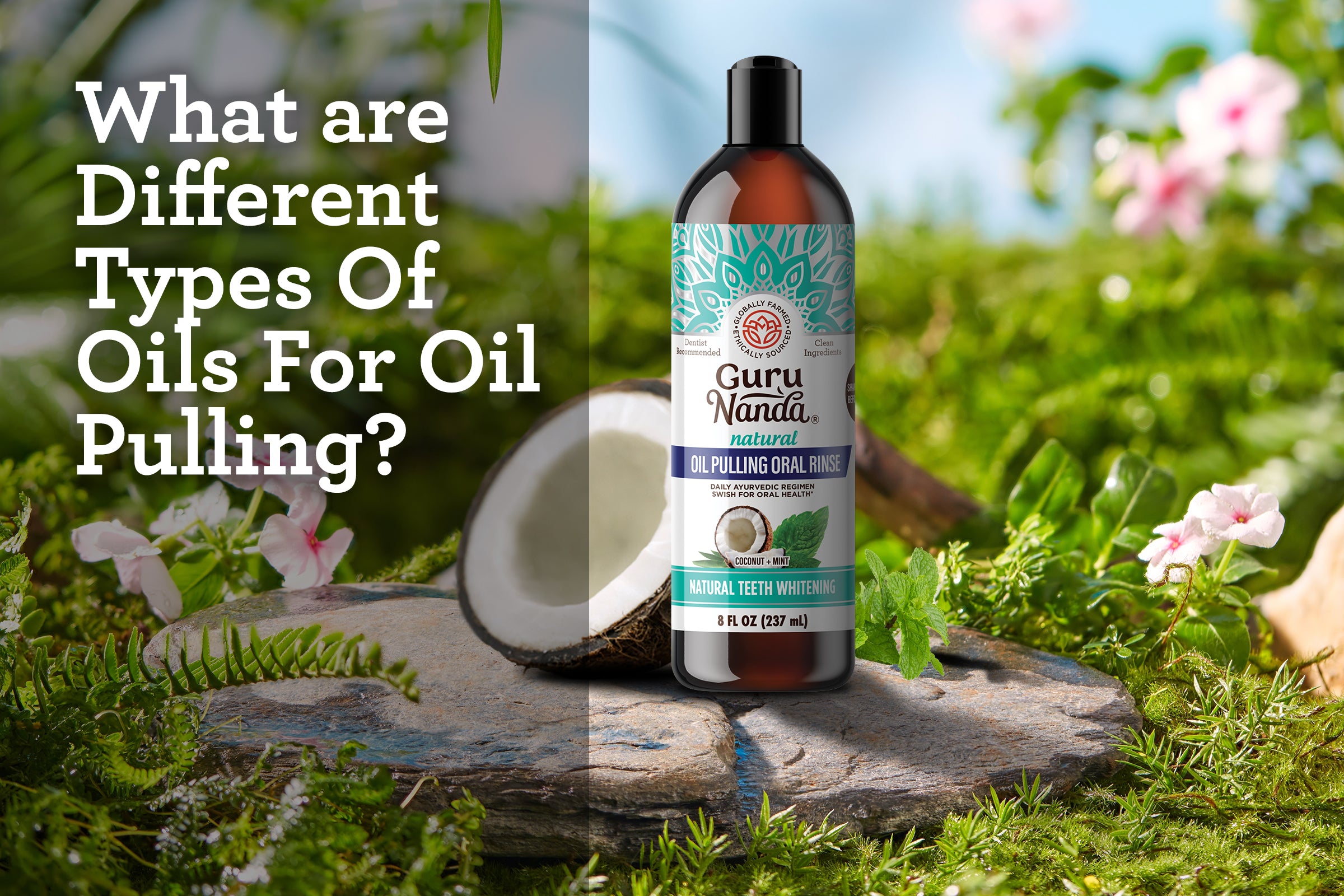Oil pulling is a traditional practice that involves swishing oil in the mouth to support oral hygiene. Among the various oils used, coconut oil has become a popular choice thanks to its antimicrobial properties and pleasant taste. That said, not all coconut oil is the same. There are three main types commonly used for oil pulling: unrefined, refined and fractionated coconut oil, which is the most refined type of coconut oil.
In this blog, we’ll break down each type, including how they’re made, their benefits and which one might be best for your routine.
Why Coconut Oil Is Popular for Oil Pulling
Coconut oil has become one of the most popular choices for oil pulling, and for good reason. Its naturally pleasant taste, thicker consistency and well-documented antimicrobial properties[1] make it a favorite among those seeking a more comfortable and effective oral care routine.
Studies have found that coconut oil pulling significantly improves gingival conditions, lowers plaque accumulation and may be just as effective as chlorhexidine in managing plaque regrowth, without the staining associated with chemical rinses[2][3][4][5].
One clinical study observed no significant difference between coconut oil pulling and chlorhexidine in reducing gingivitis markers like bleeding on probing and plaque index, but noted that coconut oil caused less tooth staining[6].

What Is Unrefined Coconut Oil?
Unrefined coconut oil (also known as virgin coconut oil) is extracted from fresh coconut meat with minimal processing[7]. It retains its natural flavor, aroma[ 7] and nutritional profile, including bioactive fatty acids like lauric acid, which has antimicrobial properties[ 1]. Because it’s not subjected to high heat or chemical refining, unrefined coconut oil preserves the full spectrum of its medium-chain fatty acids, antioxidants and polyphenols[8].
However, that natural integrity comes with some potential drawbacks.
One key concern is the presence of contaminants that would otherwise be reduced during refining. In one study, unrefined coconut oil exhibited the highest levels of polycyclic aromatic hydrocarbons (PAHs) among tested oils, including benzo(a)pyrene, a known carcinogen[9].
Another study analyzing heavy metals in commercial oils found that unrefined coconut oil had higher levels of nearly all tested metals compared to its refined counterpart[10]. While these levels didn’t exceed international safety standards, the incremental lifetime cancer risk (ILCR) for unrefined oils was higher in all age groups except adults aged 19–65[ 10].
Additionally, unrefined coconut oil’s thicker, heavier texture and strong coconut flavor can make it less pleasant to use for oil pulling[11][12]. In user studies, 16.7% of participants cited the “oily taste” as a reason for discontinuing use[ 11]. Additionally, because unrefined coconut oil is solid at room temperature[13], users must often warm it before use, which adds an extra step that can make daily routines less convenient.
The combination of its firm consistency, intense flavor and lingering oily mouth feel can be challenging for individuals with sensory sensitivities or those new to oil pulling.
What Is Refined Coconut Oil?
Refined coconut oil is made from dried coconut meat (copra) and undergoes additional processing steps, including degumming, neutralization, bleaching and deodorization. This process removes impurities, free fatty acids and the coconut aroma, resulting in a more neutral-tasting and shelf-stable oil[ 13].
Despite undergoing refinement, this oil still retains a significant amount of fatty acids, including lauric acid[14], which has well-documented antimicrobial and anti-inflammatory properties[15]. These qualities make it a practical option for oil pulling and other wellness practices, especially for those sensitive to strong flavors or aromas.
From a safety standpoint, refined coconut oil may offer a chemical advantage. Studies show that refining significantly reduces levels of heavy metals and other contaminants, which can be more prevalent in unrefined oils[ 10][ 9], suggesting a cleaner profile for long-term oral use.
However, the refining process removes many beneficial antioxidants and phenolic compounds, resulting in significantly lower levels than those found in unrefined coconut oil[16].
Additionally, even after deodorization, refined coconut oil can still retain a mildly oily texture and residual coconut flavor, which some people may find unpleasant when used for oil pulling or ingested.
What Is Fractionated Coconut Oil?
Fractionated coconut oil is a type of refined coconut oil that is made by undergoing additional processing to remove long-chain fatty acids, leaving only medium-chain triglycerides (MCTs)[17], specifically caprylic acid, or C8, and capric acid, or C10. Unlike regular coconut oil, it remains liquid at all temperatures, has a light, non-greasy texture and is completely odorless and flavorless[ 17], making it an ideal option for those with sensory sensitivities or anyone looking for a more comfortable oil-pulling experience.
Fractionated coconut oil is sometimes marketed as MCT oil; in most cases, they are functionally the same. One study that used 100% coconut-based MCT oil (chemically identical to fractionated coconut oil) showed a significant reduction in Streptococcus mutans growth and adhesion, which plays a role in cavity formation and oral biofilm development[18].
Because it’s the most refined form of coconut oil, fractionated oil is less likely to contain impurities[ 9][ 10] or allergenic residues[19] that may be found in unrefined versions. One study found that unrefined coconut oil can contain residual proteins, including a shared 110 kDa allergen present in coconut milk[ 19], which may trigger reactions in individuals with coconut allergies.
This high level of refinement does come with trade-offs. Most fractionated coconut oils contain little to no lauric acid, or C12. However, GuruNanda’s oil-pulling blends, which use a fractionated coconut oil base, are formulated to retain lauric acid and its anti-microbial benefits[ 1]. We also add essential oils like peppermint, clove, tea tree and oregano, plus oil-soluble vitamins D3, E and K2 to support whole-mouth wellness. The result: a gentle, effective formula that makes it easy to stick with a daily oral wellness habit.

Start Your Oil Pulling Routine With GuruNanda
When it comes to oil pulling, the type of coconut oil you choose can make a big difference. That’s why GuruNanda uses fractionated coconut oil as the base in our pulling oil blends, which has been formulated to retain lauric acid, so you still benefit from its antimicrobial activity. Its lightweight, always-liquid base also provides a smoother, more comfortable experience. Rooted in Ayurvedic tradition and backed by modern science, our pulling oils are crafted to support your daily wellness routine with clean ingredients and a commitment to purity.
Two of our most-loved blends include Coconut + Mint Pulling Oil, infused with seven essential oils and vitamins D3, E, and K2, and Coconut + Cinnamon Pulling Oil, which includes neem and ashwagandha. But no matter which blend you choose, every bottle is alcohol-free, fluoride-free and preservative-free to help you feel good about what you’re using.
Explore our full collection of pulling oils to find the perfect blend for your oral health routine!
- Naseem M, Khiyani MF, Nauman H, Zafar MS, Shah AH, Khalil HS. Oil pulling and importance of traditional medicine in oral health maintenance. Int J Health Sci (Qassim). 2017 Sep-Oct;11(4):65-70. PMID: 29085271; PMCID: PMC5654187. https://pubmed.ncbi.nlm.nih.gov/29085271/
- Nasution, A. H. ., & Rahmahwati, D. R. . (2017). The Effect Of Oil Pulling Using Coconut Oil On Gingival Condition In USU Dental Students. IIUM Medical Journal Malaysia, 16(2). https://doi.org/10.31436/imjm.v16i2.1114
- Priya, Ratna; Kaur, Navpreet; Rawat, Aditi; Sharma, Vivek; Bhalla, Manish; Gupta, Roopali. Effect of Coconut Oil Pulling on Plaque-Induced Gingivitis: A Prospective Clinical Study. Journal of Indian Association of Public Health Dentistry 21(3). https://journals.lww.com/aphd/fulltext/2023/21030/effect_of_coconut_oil_pulling_on_plaque_induced.8.aspx
- Kaliamoorthy, S., Vijayakumar, J., Caliaperoumal, S. K., Pazhani, A., Raju, K., Venkatesan, P., & Murugaboopathy, V. (2018). Comparing the Effect of Coconut Oil Pulling Practice with Chlorhexidine Mouth Wash in Plaque Induced Gingivitis by Evaluation of Salivary Biochemical Marker – A Comparative Interventional Study. Journal of Natural Remedies, 18(4), 151–155. https://doi.org/10.18311/jnr/2018/22799
- Mehta, Meghna1; Majumder, Prasanta2; Chowdhury, Dibyendu Dam3; Kalai, Praveen3; Adhil, K. Mohamed4; Nath, Shib Kumar3. Comparison and Evaluation of the Efficacy of Sesame Oil, Coconut Oil, and Sunflower Oil Pulling on Gingival Health—A Triple-Blind Randomized Clinical Trial. Journal of Pharmacy and Bioallied Sciences 16(Suppl 4):p S3683-S3685, December 2024. | DOI: 10.4103/jpbs.jpbs_1192_24
- Sezgin Y, Memis Ozgul B, Alptekin NO. Efficacy of oil pulling therapy with coconut oil on four-day supragingival plaque growth: A randomized crossover clinical trial. Complement Ther Med. 2019 Dec;47:102193. doi: 10.1016/j.ctim.2019.102193. Epub 2019 Sep 4. PMID: 31780023.
- Ng YJ, Tham PE, Khoo KS, Cheng CK, Chew KW, Show PL. A comprehensive review on the techniques for coconut oil extraction and its application. Bioprocess Biosyst Eng. 2021 Sep;44(9):1807-1818. doi: 10.1007/s00449-021-02577-9. Epub 2021 May 19. PMID: 34009462; PMCID: PMC8132276.
- Illam SP, Narayanankutty A, Raghavamenon AC. Polyphenols of virgin coconut oil prevent pro-oxidant mediated cell death. Toxicol Mech Methods. 2017 Jul;27(6):442-450. doi: 10.1080/15376516.2017.1320458. Epub 2017 Apr 26. PMID: 28412883. https://pubmed.ncbi.nlm.nih.gov/28412883/
- Zachara, A., Gałkowska, D. & Juszczak, L. Method Validation and Determination of Polycyclic Aromatic Hydrocarbons in Vegetable Oils by HPLC-FLD. Food Anal. Methods 10, 1078–1086 (2017). https://doi.org/10.1007/s12161-016-0673-5
- Lin S-T, Liao K-W, Xuan T-C, Chiou T-Y, Lin Z-E, Lee W-J. Determination, distribution, and health risk assessment of 12 heavy metals in various edible oils in Taiwan. JSFA Reports. 2024; 4(3): 175–183. https://doi.org/10.1002/jsf2.186
- Chanpa, P., Owittayakul, D., Wanachantararak, P., Chaiyana, W., Sookkhee, S. 2023. Formulation of coconut oil mouthwash with mixed emulsifier and its growth inhibition of Candida albicans biofilms. Nat. Life Sci. Commun. 22(1): e2023016. https://cmuj.cmu.ac.th/nlsc/journal/article/971
- Marasri, P., Sookkhee, S., Wanachantararak, P., and Owittayakul, D. 2024. Anti-inflammatory activity and wound healing ability of coconut oil mouthwash on gingival fibroblast cell in vitro. Natural and Life Sciences Communications. 23(4): e2024059. https://cmuj.cmu.ac.th/nlsc/journal/article/1087
- Shoemaker S. Refined vs. unrefined coconut oil: What’s the difference? [Internet]. Healthline Media; 2023 [cited 2025 Apr 23]. Available from: https://www.healthline.com/nutrition/refined-vs-unrefined-coconut-oil
- Liu R, Guo X, Cheng M, Zheng L, Gong M, Chang M, Jin Q, Wang X. Effects of chemical refinement on the quality of coconut oil. J Food Sci Technol. 2019 Jun;56(6):3109-3116. doi: 10.1007/s13197-019-03810-w. Epub 2019 May 16. PMID: 31205365; PMCID: PMC6542917. https://pmc.ncbi.nlm.nih.gov/articles/PMC6542917/
- M A, I MA, Ramalingam K, Shanmugam R. Biomedical Applications of Lauric Acid: A Narrative Review. Cureus. 2024 Jun 20;16(6):e62770. doi: 10.7759/cureus.62770. PMID: 39036266; PMCID: PMC11260118. https://pmc.ncbi.nlm.nih.gov/articles/PMC11260118/
- Jayathilaka N, Seneviratne K. Phenolic antioxidants in coconut oil: Factors affecting the quantity and quality. A review. Grasas aceites [Internet]. 2022Sep.8 [cited 2025Apr.24];73(3):e466. Available from: https://grasasyaceites.revistas.csic.es/index.php/grasasyaceites/article/view/1943
- Palsdottir H. What is fractionated coconut oil good for? [Internet]. Healthline Media; 2019 [cited 2025 Apr 23]. Available from: https://www.healthline.com/nutrition/fractionated-coconut-oil
- Alyami HR, Wu Y, Aljughaiman A, Li T, Almulhim A, Bliss JM, Xiao J. The effect of medium-chain triglycerides oil on Candida albicans and Streptococcus mutans in planktonic and mucosal models. Antibiotics (Basel). 2024;13(12):1231. doi:10.3390/antibiotics13121231. https://www.mdpi.com/2079-6382/13/12/1231
- Iddagoda, J., Gunasekara, P., Handunnetti, S. et al. Identification of allergens in coconut milk and oil with patients sensitized to coconut milk in Sri Lanka. Clin Mol Allergy 20, 14 (2022). https://doi.org/10.1186/s12948-022-00181-0






